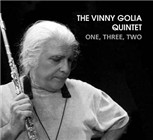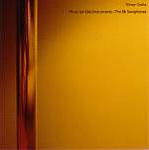Home » Jazz Articles » Interview » A Fireside Chat with Vinny Golia
A Fireside Chat with Vinny Golia
Los Angeles isn't under the microscope like New York is. There is a lot of time here to get projects together and have them realized.
 Groucho Marx coined the playful commentary: "Only one man in a 1,000 is a leader of men. The other 999 follow women." Guidance is particularly pressing for improvised music, which of late has seen a marked decline in inspiration. The Los Angeles creative community profits greatly because of men like Wadada Leo Smith, Bobby Bradford, Roberto Miranda, and Vinny Golia, are all one in a 1,000.
Groucho Marx coined the playful commentary: "Only one man in a 1,000 is a leader of men. The other 999 follow women." Guidance is particularly pressing for improvised music, which of late has seen a marked decline in inspiration. The Los Angeles creative community profits greatly because of men like Wadada Leo Smith, Bobby Bradford, Roberto Miranda, and Vinny Golia, are all one in a 1,000. All About Jazz: You were invited to the Total Music Meeting (2004).
Vinny Golia: It really went quite well. They asked me to write a piece for three bass clarinets. I was writing for Harry Sparnaay and Armand Angster, who are two of the best in the world. We each also got to do a solo piece. The theme for the opening night was bass clarinets and Eric Dolphy because it was the anniversary of his death in Berlin. The next thing I did was play with Misha Mengelberg and Han Bennink.
AAJ: The initial meeting of the trio.
VG: It was the first time we played together. I had met Misha once and Han once years ago when I was with Braxton's group. The sound check was just me and Han and that was really fun. It was just blowing. The concert had a bit more theatrics. Those guys are known for that. Musically, it was sound and we ended the concert with "Epistrophy." Then I performed in a piece by Hespos, a German composer. The great thing for me was that my tubax, the contrabass saxophone, had been redone and they sent it to me at the hotel. It was done for the concert series. So I got to play that with Han. With Han and Misha, I played flute, contrabass saxophone, sopranino, Bb clarinet, and bass clarinet.
AAJ: 9Winds' "Music for Like Instruments" series (see reviews) documents the wealth of local artistry.
VG: I've been fortunate to teach at CalArts. That's a big thing for me. Everybody who is on the flute version of the "Like Instruments" series is associated with CalArts, in one way or another. I met them all through the school. It is really an astounding place because people from all the areas of music get together and for the most part, no one is putting any perimeters on the music.
 It is just music, which is a lovely thing. On the Eb saxophones, the same thing happened. Jason Mears, Beth and Nate were all students of mine. Years ago, when I was playing with Alex and Nels, I said that I would eventually like to record something with all the instruments I play. The guy who really screwed it into place for me was John Carter. He redefined the settings for his instrument and really made these wonderful settings. I felt that I could do the same for my own instruments.
It is just music, which is a lovely thing. On the Eb saxophones, the same thing happened. Jason Mears, Beth and Nate were all students of mine. Years ago, when I was playing with Alex and Nels, I said that I would eventually like to record something with all the instruments I play. The guy who really screwed it into place for me was John Carter. He redefined the settings for his instrument and really made these wonderful settings. I felt that I could do the same for my own instruments.
These "Like Instruments" projects are a great way for me to use instruments that you can't usually play in certain settings. Even when you amplify it, the contrabass flute is still a contrabass flute and you have to deal with it in a certain way. But it really shows itself off in a nice setting when it's surrounded by the other flutes because that is what it's made to do—to voice the other flutes. The clarinet one, we will start working on in January. I've written all the music for that and I think that is going to be six clarinet players.
The beauty of L.A. is from the large ensemble, we have all these great players like Kim Richmond, whose secondary instrument, if you can call it secondary, is the clarinet. He is really a monster clarinet player. Not a lot of people know that about him. His secondary degree was in clarinet. So Kim would be great.
Then at school, I have people who have studied with me like Jim Sullivan and Brian Walsh. They are really great clarinet and bass clarinetists. So that is a natural lock. And then in the large ensemble, Andrew Pask came into replace Steve Adams for one of the concerts and his primary instrument is the clarinet and bass clarinet. As a matter of fact, we've played some clarinet duos, so he has to be in it. So you see, it just snowballs. Once you see the talent that's here, it's hard not to tap into it.
 AAJ: Last year, Belgium label jazz'halo (see One, Three, Two review) and Canadian label Red Toucan have released recordings of your various ensembles. And Portuguese label Clean Feed is scheduled to release another this year.
AAJ: Last year, Belgium label jazz'halo (see One, Three, Two review) and Canadian label Red Toucan have released recordings of your various ensembles. And Portuguese label Clean Feed is scheduled to release another this year.
VG: Yes, with Bobby Bradford, Alex, and Ken Filiano. 9Winds has been around for thirty years and people know about the scene from dealing with the recordings from that aspect. People also know about the musicians here because of the work on Jeff Gauthier's Cryptogramophone and Jeff Kaiser's pfMENTUM label. In the '70s, there was a label here called Black Jazz that really documented the players here and also Nimbus, recording all the people associated with the Ark. There has been a fair amount of documentation in recordings, but none of the people have seen us. Los Angeles isn't under the microscope like New York is. There is a lot of time here to get projects together and have them realized. Everybody here plays together on a regular basis.
AAJ: Artist/indie labels seems to be the creative well for the music. Both Dave Holland and Dave Douglas have introduced their own labels.
VG: The advantage that they have over us is that they were with labels that had jazz departments. Those guys bought a lot of advertising. Regardless of what anyone thinks of their music, when it comes to advertising, it's almost inconsequential because they create a public awareness of those players. So if those players do just a pittance of advertising, they will come out pretty good because the work has already been done for them.
I remember when Tim Berne was with Columbia, they took out a lot of advertising and did a fair amount of promotion for him and deservedly so because the records that he did on Columbia were really great records. That as carried through the years. Tim has delivered and built on that platform of advertising. Now, he has his own label again. He was one of the early guys. He had a label in '78. He has returned to it, but now he has that platform of advertising that's been done. Guys like Dave Douglas and Holland, if they're going to start their own labels—all they really have to do is put out music is comparable to the music they put out before. With the caliber of musicianship of Douglas and Holland, that's not going to be a problem. They should give me advice.
 AAJ: As an educator, how do you encourage students of a music that is hardly mainstream and often discounted?
AAJ: As an educator, how do you encourage students of a music that is hardly mainstream and often discounted?
VG: One of the great things about CalArts is that everybody there who teaches is also on the road an amount. So the students come there to partake of the faculty, but they also have the awareness that the teachers are going to be out of town. When they see that, you don't have to say a word because you are putting your money where your mouth is. It is actually harder to see us locally than it is to see us in any of these other places.
You have a better chance in the spring and fall to see us play on the East Coast or the Mid-West or even in the Southwest than you do in L.A. The students see us and ask questions about that and ask questions about the people you played with and what the scene is like here or there. You can answer these questions because you play with these people and are part of the scene. The action is a greater thing that just sitting there and talking about it. I think that is the biggest thing about CalArts. We talk more about what they want to do, why they want to do it, and where they want to do it. Once we start talking about those things, then everything else falls into place for them.
AAJ: As a student of the music, you have pursued instrumental challenges. What's next?
VG: I'm patiently waiting for a new bass saxophone to do the Bb version of the "Like Instruments", which will be done after the clarinets. The guy who made my tubax has redesigned the bass saxophone. He hasn't changed the outside design of it, but the inside dimensions, everything is larger. So the sound is really beautiful and huge. I will be getting one of the first ones that he's making.
AAJ: And the future?
VG: I am finishing up some commissions for some people I met in Europe. Then I am doing an East Coast tour with Adam Lane in February. I am going to Belgium with Peter Schmid from the Leo record. I will be back to Europe in May to do Macbeth, which just closed here at REDCAT. We're doing London and Dublin and a few other places.
AAJ: It is a one man Macbeth.
VG: It is a one man Macbeth with three musicians. I wrote some music and then I picked Jeremy and Harris to perform with. They played great. The music was pretty simple and there was a lot of improvising involved because Stephen would play the characters differently each night. It was really fantastic and a lot of fun. Stephen was just unbelievable. I was in awe of his performances.
Visit Vinny Golia on the web.
< Previous
Doyle's Brunch
Comments
Tags
For the Love of Jazz
 All About Jazz has been a pillar of jazz since 1995, championing it as an art form and, more importantly, supporting the musicians who create it. Our enduring commitment has made "AAJ" one of the most culturally important websites of its kind, read by hundreds of thousands of fans, musicians and industry figures every month.
All About Jazz has been a pillar of jazz since 1995, championing it as an art form and, more importantly, supporting the musicians who create it. Our enduring commitment has made "AAJ" one of the most culturally important websites of its kind, read by hundreds of thousands of fans, musicians and industry figures every month.






















